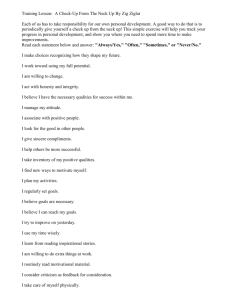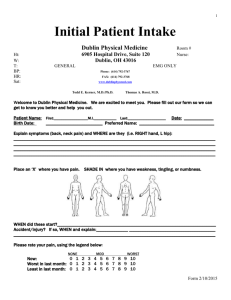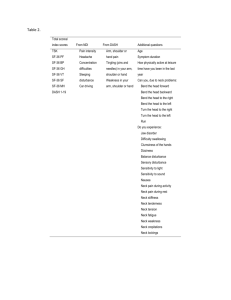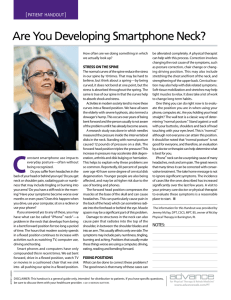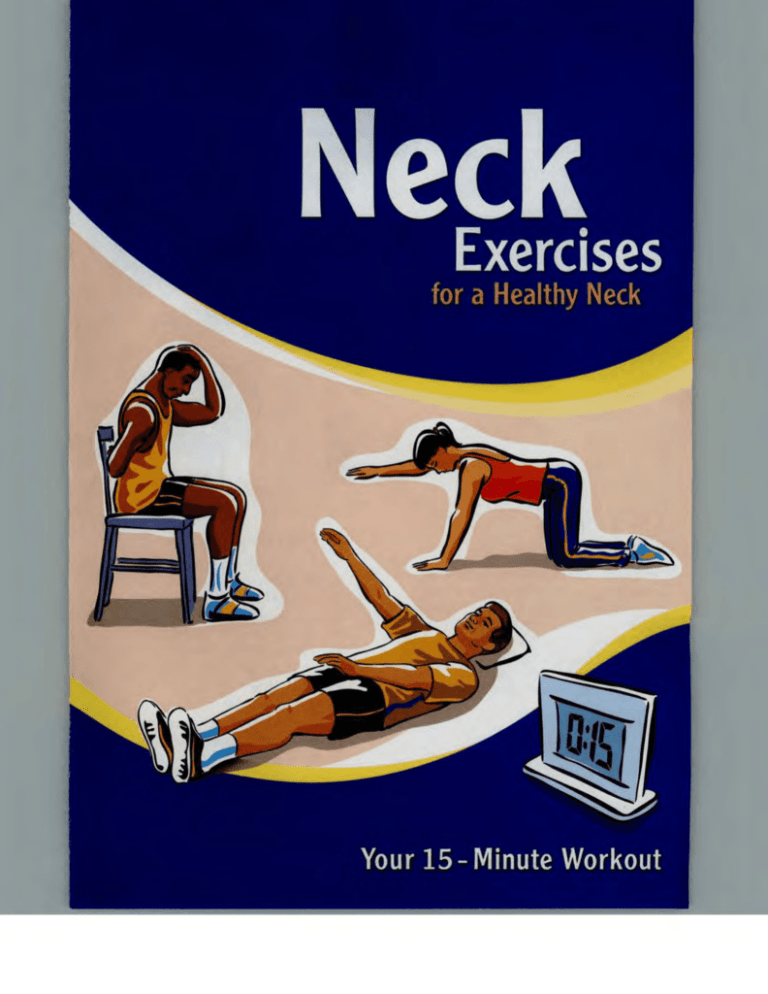
Why Do Neck Exercises?
Most people have neck pain or discomfort at some time in their
lives. Neck exercises can help relieve this pain and stiffness. They
also aid in recovery from an injury. And exercises help you keep
your neck strong and flexible.
Why Your Neck Hurts
Neck pain can be due to many causes.
These include:
• Stress, strain, and overuse
• Poor posture (how you hold your body)
and body mechanics (ways of moving)
• Weakened muscles and joints
• Accident or injury
A Neck Exercise
Program That Works
Doing neck exercises can improve the strength
and flexibility of the muscles in your neck,
shoulders, and upper back. This helps support
your neck, improves circulation, and reduces
pain. The exercises in this booklet take just 15
or 20 minutes total to do. They can help you
relax, improve your posture, and increase your
neck's strength and range of motion.
2
Exercise Tips
• Thlk to your healthcare provider before
starting an exercise program, especially
if you have a history of neck problems.
• Expect some soreness at first. If pain
worsens, stop the exercise and check
with your healthcare provider.
• Pace yourself. Start slow and work up
to more vigorous exercise.
• Breathe slowly and deeply.
• Stretch slowly. Don't jerk or bounce.
• Exercise regularly, as directed by your
healthcare provider.
This booklet is not intended as a substitute for professional healthcare.
See your healthcare professional before undertaking any significant lifestyle change.
C2003 The StayWell Company, 1100 Grundy Lane, San Bruno, CA 94066-3030.
www.krames.com 800-333-3032. All rights reserved. Lithographed in Canada.
Know Your Neck
A healthy neck supports the head, keeping it aligned with the rest of
your spine. When the neck's bones, disks, and muscles are in good
condition, they allow you to move your head freely and without pain.
Your Spine'sThree Natural Curves
The spine is arranged in three curves: cervical
(neck), thoradc (mid-back), and lumbar (low back).
When they are properly aligned, these curves
support your weight comfortably. The curves are
maintained when you are relaxed and your ears,
shoulders, and hips are in a straight line. This
is called a neutral position.
Moving Your Neck
f
Ahealthy neck can move easily, without
discomfort. The neck moves in three
basic ways. During:
• Flexion and extension, the head moves
forward and backward.
• Rotation, the head turns left and right.
• Lateral bending, the head tilts, ear toward
the shoulder.
Disk -
--+- -+----'--
Parts of the Neck
Vertebrae are the bones that form the
spine. They protect the spinal cord and
connect the neck and head. Disks are
pads of spongy tissue that cushion the
vertebrae.
Muscles in the
neck, upper back,
and shoulder
support and
move the neck
and head.
Joints link the vertebrae and allow them
to move smoothly.
<--~
Nerves branch out from the spinal cord
between the vertebrae. They let signals
travel between the brain and the rest of
the body.
3
Your 15-Minute Neck Exercise Program
...
This short workout includes both stretching and strengthening exercises.
Do the workout as often as suggested by your healthcare provider. Use an
exercise mat, pillow, or folded towel to support your head and to protect
sensitive areas such as your knees.
··· ••·······•••
··· ······ ············ ········ ··· ········································ ······
STARTING POSITION
Lie on your back, knees bent and feet flat on the
floor. Keep your ears, shoulders, and hips aligned,
but don't press your lower back to the floor. Rest
your hands on your pelvis. Breathe deeply and relax .
Return to this position after each exercise in this set.
······•····
······ ···•··
0
0
NECK (DORSAL) GLIDE
Gently flatten the curve of your neck against the floor.
Lengthen your neck as though you're growing taller.
Don't jam your chin into your chest, and don't push
too hard. Hold for 5 seconds. Repeat 3 or _ _ times.
·····•·· ················ ······· ················· ······ ···· ··· ···•
From starting position, drop
both knees to one side. At
the same time, turn your
head and look in the other
direction. Keep both feet in
contact with the floor and
keep your arms at your
sides. Hold for 5 seconds.
Then slowly switch sides.
Repeat 5 or _ _ times.
Stand tall with your ears,
shoulders, and hips in line.
Your feet should be slightly
apart, positioned just under
your hips. Focus your eyes
directly in front of you. Stand
in this position for a few
seconds before starting
your exercises. This helps
increase your awareness
of proper posture.
4
...... .......•.. ,
Imagine facing a c lock.
With your nose, slowly
trace the outer edge of the
clock. Move clockwise first,
then counterclockwise.
Repeat 3 or _ _ times.
•··· ····•··•··•··•• ••·····•·•···•····••·••·•·•·· ·•·•· ··•
STARTING POSITION
······ ··· ••·•·······
0 HEAD CLOCK
NECK AND TORSO ROTATION
··•·•·•··•
·•·•·••·•·• ···•··
·····•••••·· ·•·•···•··•·••·••
0
••• ••··•·• •··•···•··• ··· ··•
•··•·•···••···•
SHOULDER CLOCK
Imagine that your right
shoulder is the center of a
clock. With your shoulder
slowly trace the outer edge
of the clock. M011e clockwise
first, then counterclockwise.
times.
Repeat 3 or _
Switch shoulders.
•···•••··•·· ·•·• ·· •··••· ··•····
D
•·••··•···••····· ·•···· •··•····•·····• ··•·••····· ·••·····•·········· •·
D
PASSIVE NECK ROTATION
ACTIVE NECK ROTATION
Wrth your neck relaxed, place
the palm of one hand on your
forehead. Use your hand to
turn your head from side to
side until you feel a stretch
In the neck muscles. Keep
your shoulders on the floor
and your chin In a neutral
position. Hold for 5 seconds.
Repeat 5 or _ _ times.
···· ··· ·····•···········•·· ···· ·
D
Use your neck muscles to
turn your head from side to
side until you feel a stretch
in the muscles. Keep your
shoulders on the floor. Don't
lift your chin as you turn your
head. Hold for 5 seconds.
Repeat 5 or __ times.
·••·····•· ··••····•··• ••· ·••··•·······••····•·•·••·•·•···• ········
D
ARM LIFTS
Raise one arm overhead, then lower it. As you lower
that arm, raise the other arm. Continue to move both
arms in slow, smooth arcs. Keep your arms straight
and your head and neck relaxed. Repeat 5 or __
times with each arm.
······ ·····•·· •••·· ····
·•······• ·····••···•·• ·•·
ARM AND UPPER BODY CIRCLE
Lie on your right side, knees bent. Support your head with a
pillow to keep your neck In line with the rest of your spine. Ue
with your left knee slightly In front of the right knee, right hand on
your left knee. Slowly move your left arm in a circle. Repeat 5
or __ times. Reverse direction. Switch sides.
.......··························· ····· ··· ······· ······· ....... .······ ······· ············
·········•···· •·· ···•·········· ...
0
Reach overhead
and slightly back
with both arms.
SHOULDER AND UPPER BACK STRETCH
With your palms facing
the ceiling, turn your
fingers inward. Take a
deep breath.
Breathe out and lower your
elbows toward your buttocks.
Keep your shoulders and neck
aligned and your elbows
behind your shoulders. Hold
for 5 seconds, then return
to starting position. Repeat
3 or __ times.
5
STARTING POSITION
Sit in a chair with your feet
flat on the floor. Your weight
should be slightly forward
so that you're balanced
evenly on your buttocks.
Relax your shoulders, keep
your head level, and main·
lain your three natural
curves. Using a chair with
arms may help you keep
your balance.
,
·•·•···•·····
0
NECK ROTATION WITH WEIGHT SHIFT
Step 1. Shift your weight
onto your right hlp and look
over your left shoulder. Hold
for 3 seconds. Switch sides.
Repeat 5 or __ times.
Step 2. As you turn, reach
your right arm across your
body. Hold for 3 seconds.
Switch sides. Repeat 5 or
_ _ times.
·········•· ········· ··········· ············· ·········· •·•········· ··· ····· ···•········
0
SHOULDER GIRDLE STRETCH
0
SHOULDER ISOMETRICS
Raise your arms, elbows
bent, to shoulder height.
Slowly move your forearms together. Hold for 5
seconds. Return to starting position. Repeat 5 or
times.
Place one hand on the
outside elbow of the
other arm. Pull the arm
across your body. Hold
for 20 seconds. Switch
sides.
.... ·············
•·············•·················· ···· ······ ····•·············· ·····•······•··
STARTING POSITION
Move to your hands and knees. Keep your knees
under your hips and your hands under your shoulders.
Keep your spine in a neutral position {not arched or
sagging). Keep your ears in line with your shoulders.
Hold for a few seconds before starting your exercises.
6
····· ····••··•··········
0
··•··••·•··•····•••·•••····•••·
HEAD LIFTS
Keeping your back straight, slowly drop your chin
toward your chest. Tuck in your chin. Hold for
5 seconds. Then lift your head until your neck is
level with your back. Hold for 5 seconds. Repeat
5or __ times.
0
0
NECK fLEX
Rest the back of your left hand
against your lower back. Place
your right palm on the top of
your head. Gently pull your
head forward and down until
you feel a stretch in the neck
muscles. Don't force the
motion. Hold for 20 seconds,
then return to starting position.
Switch arms.
•······•·····•·········•··•·•
0
Rest the back of your left hand
against your lower back. Place
your right palm just above your
left ear. Gently pull your head
to the right until you feel a
stretch in the neck muscles.
Hold for 20 seconds, then
return to starting position. Do
the exercise again, this time
pulling your head forward
diagonally. Switch sides.
······················ ······························ ·············•·····
SHOULDER SQUEEZE
Raise your arms with your
elbows bent, upper arms
at or just below shoulder
level. Your palms should
lace forward. Move your
arms back, squeezing your
shoulder blades together.
Hold 5 seconds. Return to
starting position. Repeat
5 or _ _ times.
·······················•·············
0
SIDE BEND
0
Step 1. Press your
palm against your
forehead. Resist with
your neck muscles.
Hold for 5 seconds.
Relax. Repeat 5 or
times.
················•·· ··•··•
NECK ISOMETRICS
Step 2. Do the
exercise again,
pressing on the
side of your head.
Repeat 5 or __
times. SWitch sides.
················· ··•·•·•······ ·· ·•················· ·······
Step 3. Do the
exercise again,
pressing on the
back of your
head. Repeat 5
or __ times.
•·············· ··············
REACH AND HOLD
MOVING AERoBICAllY
Step 1. Tighten your abdominal muscles and raise
one hand straight in front of you, palm down. Hold
for 5 seconds, then lower. Repeat 5 or _ _ times.
Step 2. Do the exercise again, this time lifting your
arm to the side. Repeat 5 or _ _ times.
Step 3. Do the exercise again, this time lifting your
arm backward, palm up. Repeat 5 or _ _ times.
Switch sides and do the exercise with the other arm.
Aerobic exercise conditions the heart and
lungs, and tones muscles. It helps you
control your weight And it improves your
body's natural pain-control system. All of
this helps keep your neck and back in good
shape. Types of aerobic exercise include
walking, swimming, bicycling, water
aerobics, and others. Choose one or choose
a combination to fit your mood and the
season. Aim for at least 20 minutes of
aerobic exercise 3 to 5 times a week.
7
Keeping Your Neck in Mind
Doing these neck exercises regularly can help you reduce pain,
stiffness, and fatigue. As you work, rest, or play, keep your neck
in mind. Practice better posture to reduce your aches and pains
so that you'll feel better each day.
Consultant:
John L. Ceglia, PT, ATC,
Orthopaedic Sports Medicine
With contributions by:
Jacalyn Buettner, DC
Ben Kivlan, PT, Orthopaedic Sports Therapy
Roger Pack, MPT, OCS
Michael S. Sutro, MD, Orthopaedic Surgery
Michael Yoon, MD, Neurosurgery
11380
•• KRAMES
1111:
Hulth and Safety Education
This proclud also
available In Spanish
a division of ~I
0307


